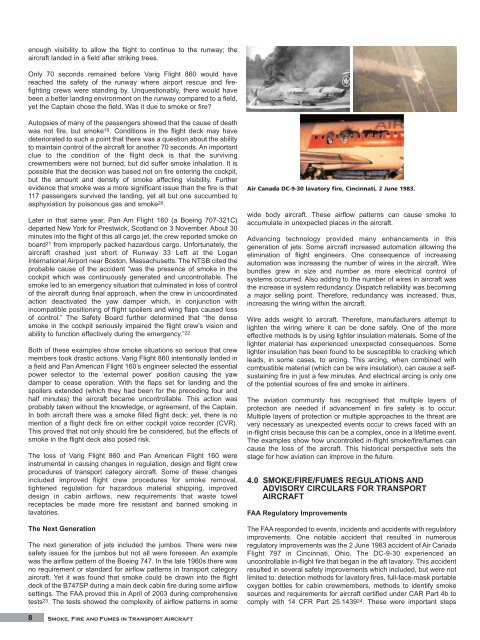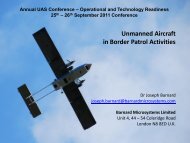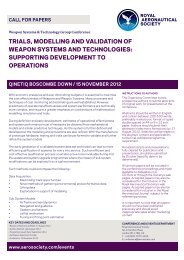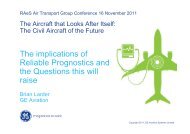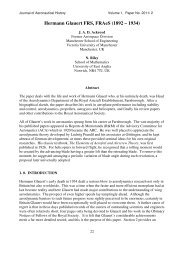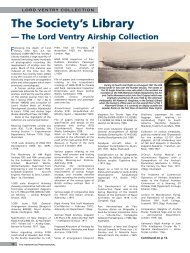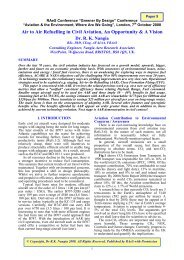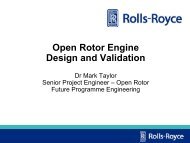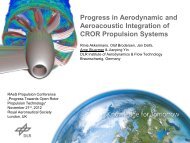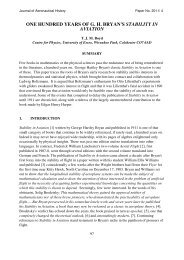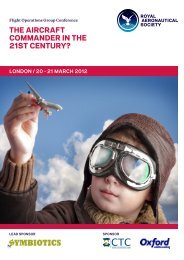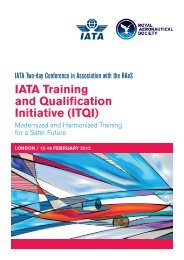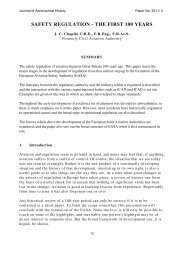Smoke, Fire and Fumes in Transport Aircraft - Royal Aeronautical ...
Smoke, Fire and Fumes in Transport Aircraft - Royal Aeronautical ...
Smoke, Fire and Fumes in Transport Aircraft - Royal Aeronautical ...
Create successful ePaper yourself
Turn your PDF publications into a flip-book with our unique Google optimized e-Paper software.
enough visibility to allow the flight to cont<strong>in</strong>ue to the runway; the<br />
aircraft l<strong>and</strong>ed <strong>in</strong> a field after strik<strong>in</strong>g trees.<br />
Only 70 seconds rema<strong>in</strong>ed before Varig Flight 860 would have<br />
reached the safety of the runway where airport rescue <strong>and</strong> firefight<strong>in</strong>g<br />
crews were st<strong>and</strong><strong>in</strong>g by. Unquestionably, there would have<br />
been a better l<strong>and</strong><strong>in</strong>g environment on the runway compared to a field,<br />
yet the Capta<strong>in</strong> chose the field. Was it due to smoke or fire?<br />
Autopsies of many of the passengers showed that the cause of death<br />
was not fire, but smoke 19. Conditions <strong>in</strong> the flight deck may have<br />
deteriorated to such a po<strong>in</strong>t that there was a question about the ability<br />
to ma<strong>in</strong>ta<strong>in</strong> control of the aircraft for another 70 seconds. An important<br />
clue to the condition of the flight deck is that the surviv<strong>in</strong>g<br />
crewmembers were not burned, but did suffer smoke <strong>in</strong>halation. It is<br />
possible that the decision was based not on fire enter<strong>in</strong>g the cockpit,<br />
but the amount <strong>and</strong> density of smoke affect<strong>in</strong>g visibility. Further<br />
evidence that smoke was a more significant issue than the fire is that<br />
117 passengers survived the l<strong>and</strong><strong>in</strong>g, yet all but one succumbed to<br />
asphyxiation by poisonous gas <strong>and</strong> smoke 20.<br />
Later <strong>in</strong> that same year, Pan Am Flight 160 (a Boe<strong>in</strong>g 707-321C)<br />
departed New York for Prestwick, Scotl<strong>and</strong> on 3 November. About 30<br />
m<strong>in</strong>utes <strong>in</strong>to the flight of this all cargo jet, the crew reported smoke on<br />
board 21 from improperly packed hazardous cargo. Unfortunately, the<br />
aircraft crashed just short of Runway 33 Left at the Logan<br />
International Airport near Boston, Massachusetts. The NTSB cited the<br />
probable cause of the accident “was the presence of smoke <strong>in</strong> the<br />
cockpit which was cont<strong>in</strong>uously generated <strong>and</strong> uncontrollable. The<br />
smoke led to an emergency situation that culm<strong>in</strong>ated <strong>in</strong> loss of control<br />
of the aircraft dur<strong>in</strong>g f<strong>in</strong>al approach, when the crew <strong>in</strong> uncoord<strong>in</strong>ated<br />
action deactivated the yaw damper which, <strong>in</strong> conjunction with<br />
<strong>in</strong>compatible position<strong>in</strong>g of flight spoilers <strong>and</strong> w<strong>in</strong>g flaps caused loss<br />
of control.” The Safety Board further determ<strong>in</strong>ed that “the dense<br />
smoke <strong>in</strong> the cockpit seriously impaired the flight crew’s vision <strong>and</strong><br />
ability to function effectively dur<strong>in</strong>g the emergency.” 22<br />
Both of these examples show smoke situations so serious that crew<br />
members took drastic actions. Varig Flight 860 <strong>in</strong>tentionally l<strong>and</strong>ed <strong>in</strong><br />
a field <strong>and</strong> Pan American Flight 160’s eng<strong>in</strong>eer selected the essential<br />
power selector to the ‘external power’ position caus<strong>in</strong>g the yaw<br />
damper to cease operation. With the flaps set for l<strong>and</strong><strong>in</strong>g <strong>and</strong> the<br />
spoilers extended (which they had been for the preced<strong>in</strong>g four <strong>and</strong><br />
half m<strong>in</strong>utes) the aircraft became uncontrollable. This action was<br />
probably taken without the knowledge, or agreement, of the Capta<strong>in</strong>.<br />
In both aircraft there was a smoke filled flight deck; yet, there is no<br />
mention of a flight deck fire on either cockpit voice recorder (CVR).<br />
This proved that not only should fire be considered, but the effects of<br />
smoke <strong>in</strong> the flight deck also posed risk.<br />
The loss of Varig Flight 860 <strong>and</strong> Pan American Flight 160 were<br />
<strong>in</strong>strumental <strong>in</strong> caus<strong>in</strong>g changes <strong>in</strong> regulation, design <strong>and</strong> flight crew<br />
procedures of transport category aircraft. Some of these changes<br />
<strong>in</strong>cluded improved flight crew procedures for smoke removal,<br />
tightened regulation for hazardous material shipp<strong>in</strong>g, improved<br />
design <strong>in</strong> cab<strong>in</strong> airflows, new requirements that waste towel<br />
receptacles be made more fire resistant <strong>and</strong> banned smok<strong>in</strong>g <strong>in</strong><br />
lavatories.<br />
The Next Generation<br />
The next generation of jets <strong>in</strong>cluded the jumbos. There were new<br />
safety issues for the jumbos but not all were foreseen. An example<br />
was the airflow pattern of the Boe<strong>in</strong>g 747. In the late 1960s there was<br />
no requirement or st<strong>and</strong>ard for airflow patterns <strong>in</strong> transport category<br />
aircraft. Yet it was found that smoke could be drawn <strong>in</strong>to the flight<br />
deck of the B747SP dur<strong>in</strong>g a ma<strong>in</strong> deck cab<strong>in</strong> fire dur<strong>in</strong>g some airflow<br />
sett<strong>in</strong>gs. The FAA proved this <strong>in</strong> April of 2003 dur<strong>in</strong>g comprehensive<br />
tests 23. The tests showed the complexity of airflow patterns <strong>in</strong> some<br />
8<br />
<strong>Smoke</strong>, <strong>Fire</strong> <strong>and</strong> <strong>Fumes</strong> <strong>in</strong> <strong>Transport</strong> <strong>Aircraft</strong><br />
Air Canada DC-9-30 lavatory fire, C<strong>in</strong>c<strong>in</strong>nati, 2 June 1983.<br />
wide body aircraft. These airflow patterns can cause smoke to<br />
accumulate <strong>in</strong> unexpected places <strong>in</strong> the aircraft.<br />
Advanc<strong>in</strong>g technology provided many enhancements <strong>in</strong> this<br />
generation of jets. Some aircraft <strong>in</strong>creased automation allow<strong>in</strong>g the<br />
elim<strong>in</strong>ation of flight eng<strong>in</strong>eers. One consequence of <strong>in</strong>creas<strong>in</strong>g<br />
automation was <strong>in</strong>creas<strong>in</strong>g the number of wires <strong>in</strong> the aircraft. Wire<br />
bundles grew <strong>in</strong> size <strong>and</strong> number as more electrical control of<br />
systems occurred. Also add<strong>in</strong>g to the number of wires <strong>in</strong> aircraft was<br />
the <strong>in</strong>crease <strong>in</strong> system redundancy. Dispatch reliability was becom<strong>in</strong>g<br />
a major sell<strong>in</strong>g po<strong>in</strong>t. Therefore, redundancy was <strong>in</strong>creased, thus,<br />
<strong>in</strong>creas<strong>in</strong>g the wir<strong>in</strong>g with<strong>in</strong> the aircraft.<br />
Wire adds weight to aircraft. Therefore, manufacturers attempt to<br />
lighten the wir<strong>in</strong>g where it can be done safely. One of the more<br />
effective methods is by us<strong>in</strong>g lighter <strong>in</strong>sulation materials. Some of the<br />
lighter material has experienced unexpected consequences. Some<br />
lighter <strong>in</strong>sulation has been found to be susceptible to crack<strong>in</strong>g which<br />
leads, <strong>in</strong> some cases, to arc<strong>in</strong>g. This arc<strong>in</strong>g, when comb<strong>in</strong>ed with<br />
combustible material (which can be wire <strong>in</strong>sulation), can cause a selfsusta<strong>in</strong><strong>in</strong>g<br />
fire <strong>in</strong> just a few m<strong>in</strong>utes. And electrical arc<strong>in</strong>g is only one<br />
of the potential sources of fire <strong>and</strong> smoke <strong>in</strong> airl<strong>in</strong>ers.<br />
The aviation community has recognised that multiple layers of<br />
protection are needed if advancement <strong>in</strong> fire safety is to occur.<br />
Multiple layers of protection or multiple approaches to the threat are<br />
very necessary as unexpected events occur to crews faced with an<br />
<strong>in</strong>-flight crisis because this can be a complex, once <strong>in</strong> a lifetime event.<br />
The examples show how uncontrolled <strong>in</strong>-flight smoke/fire/fumes can<br />
cause the loss of the aircraft. This historical perspective sets the<br />
stage for how aviation can improve <strong>in</strong> the future.<br />
4.0 SMOKE/FIRE/FUMES REGULATIONS AND<br />
ADVISORY CIRCULARS FOR TRANSPORT<br />
AIRCRAFT<br />
FAA Regulatory Improvements<br />
The FAA responded to events, <strong>in</strong>cidents <strong>and</strong> accidents with regulatory<br />
improvements. One notable accident that resulted <strong>in</strong> numerous<br />
regulatory improvements was the 2 June 1983 accident of Air Canada<br />
Flight 797 <strong>in</strong> C<strong>in</strong>c<strong>in</strong>nati, Ohio. The DC-9-30 experienced an<br />
uncontrollable <strong>in</strong>-flight fire that began <strong>in</strong> the aft lavatory. This accident<br />
resulted <strong>in</strong> several safety improvements which <strong>in</strong>cluded, but were not<br />
limited to: detection methods for lavatory fires, full-face-mask portable<br />
oxygen bottles for cab<strong>in</strong> crewmembers, methods to identify smoke<br />
sources <strong>and</strong> requirements for aircraft certified under CAR Part 4b to<br />
comply with 14 CFR Part 25.1439 24. These were important steps


